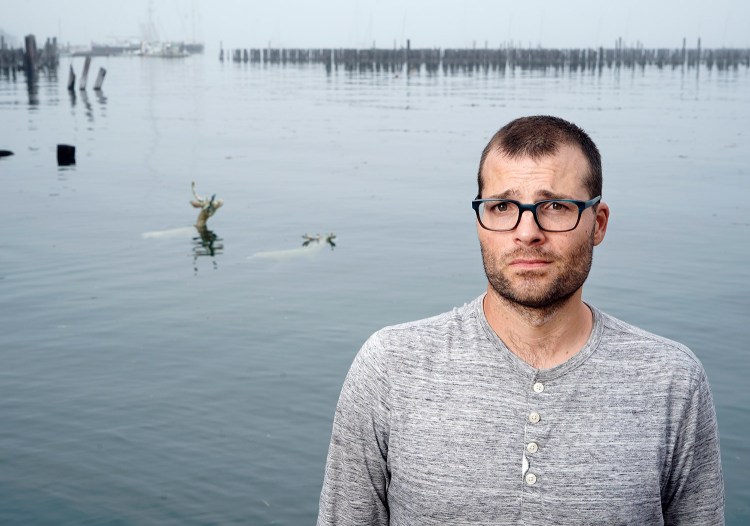Three years after he placed a pack of lifelike dogs atop pilings on the Portland waterfront, artist Andy Rosen is back with another installation of animals, this time a pair of deer emerging from the rising sea near the Ocean Gateway marine facility.
The dogs were like a pop song – catchy and memorable. The deer are more subtle, their impact perhaps easier to appreciate over time.
“I hope people will sit and watch,” Rosen said Monday, watching himself as the life-size deer that he placed in the water became submerged at the midday high tide. “Slowing down and looking is about the environment and being aware of what is happening to the environment. That’s what this is about.”

The head of a deer sculpture is just visible above the water of Portland Harbor.
His project, funded with a grant from the Union of Concerned Scientists, calls attention to climate change and rising sea levels, as well as the role of science in public discourse and policies. It illustrates that rising sea levels are claiming land that animals and people depend on and turning land-based animals into seafarers.
Rosen was among six artists or artist collectives nationwide who received a $10,000 grant from the Union of Concerned Scientists as part of its Art for Science Rising effort, which is organizing around the #sciencerising hashtag. Rosen’s project, called “Tread,” is the first of the six to open. The others will follow later this year and include an outdoor mural, video projections, billboards and highway signs.
The national movement is meant to push elected officials to use science in their decision-making processes and highlight the importance of science in protecting public health and safety, said Roger Stephenson of Stratham, New Hampshire, advocacy director for the Northeast region.
“Science Rising is nationwide mobilization taking place through the year through a series of local activities, events and actions organized by many, many different groups with the shared goal of seeing that science is front and center in the decision-making processes that affect us all, and to fight back against efforts to sideline science,” Stephenson said. “Science has a crucial role in our democracy. Decision-makers from city councilors to the president of the United States make decisions that affect us all, that affect our public health, our transportation options and even the seafood that is available or not available. Those decisions have to be grounded in science.”

Artist Andy Rosen placed two deer sculptures in Portland Harbor near the Ocean Gateway terminal. His project, funded with a grant from the Union of Concerned Scientists, calls attention to climate change and rising sea levels.
Rosen constructed his deer out of aluminum, steel and foam, and supports them with slender stilts made with black locust, a hardwood. At low tide, the deer are entirely visible, stilts included. Depending on the height of the tide, they’ll be submerged, in over their heads and struggling to stay afloat as they swim from the mainland to a distant shore.
The installation will be on view through mid-November.
Rosen, who lives in South Portland, will talk about the project at 2 p.m. Sunday at the installation. If it’s raining, the talk will move to the Maine Jewish Museum, which is co-sponsoring the installation along with the University of New England and the Maine Arts Commission.
Rosen placed his deer near the cruise-ship terminal as a way to create contrast between the natural world and man’s intrusion on that world. There wasn’t a large ship in port Monday when Rosen spoke about his art, but the busy cruise ship season is coming up. “At some point, there will be a cruise ship here, and it will be immense. The contrast of traveling for pleasure and traveling out of necessity will be pretty stark,” he said.

Two deer sculptures are placed in Portland Harbor to call attention to climate change and rising sea levels, as well as the role of science in public discourse and policies.
“Tread” is very much in line with other projects Rosen has completed over the years. Through his sculpture and paintings, Rosen’s art practice involves bringing attention to the natural world by gently reminding people of the need to respect it. He was an artist in residence at the Scarborough Transfer Station in summer 2013 and created a black bear from discarded materials. He’s also placed a wolf entangled by a garden hose in a gallery.
Issues such as climate change and rising sea levels exist in the abstract, he said. He wants his art to give form to those issues, to make them more tangible. “What I have been doing with all of my artwork over 15 years is to ask questions, what do those things mean specifically? The making of artwork is a way to dig into those ideas without being preachy about it,” he said.
Stephenson said the Union of Concerned Scientists invested in art to help spread its message because art reaches people in different ways than a science report. Art affects people viscerally and creates “greater awareness and appreciation of the challenges we face. We hope that these installations get people thinking and talking,” he said.
Tom Jensen of Portland came out with his camera at midday Monday. He captures photographic images along the waterfront nearly every morning and noticed the deer at low tide during his early-morning rounds. He returned near high tide for another look, at one point hanging over the granite boulders at the water’s edge for a better angle.
As the water lapped around the heads of the deer, Jensen was impressed.
“I have the feeling I will try to get them in a silhouette at sunrise,” he said.
Bob Keyes can be contacted at 791-6457 or at:
bkeyes@pressherald.com
Twitter: pphbkeyes
Send questions/comments to the editors.




Comments are no longer available on this story